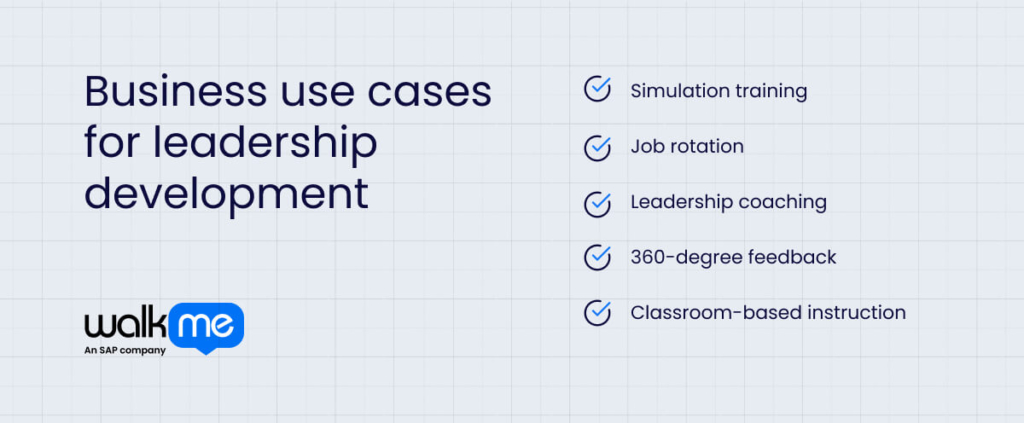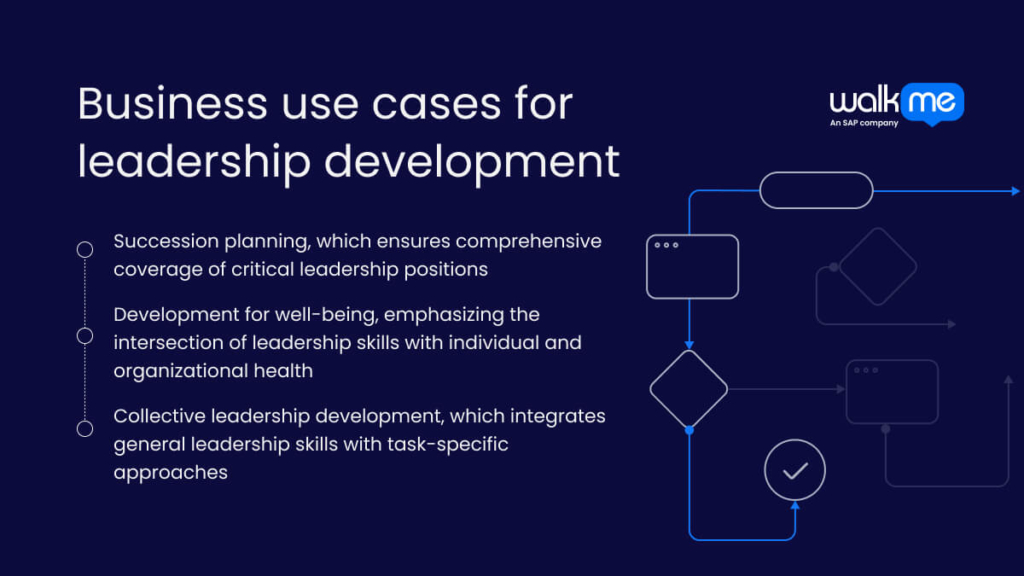The latest Harvard Business Global Leadership Development Study highlights the importance of preparing leaders to navigate rapidly changing technological and societal challenges.
As leadership demands evolve, organizations must adapt their development strategies to equip leaders with the skills to thrive in this environment.
Leadership development is a type of employee training that enhances decision-making, communication, and strategic thinking skills. It helps leaders manage change, drive digital innovation, and encourage strong team dynamics.
While elevating staff to leadership positions is challenging, innovations in leadership development provide the tools to guide your company’s success.
This article explores how businesses can advance leadership development. We’ll start with a definition, examine effective methods, and show you how to set specific goals.
What is leadership development?
Leadership development is the systematic and intentional process of enhancing individuals’ skills, abilities, and qualities to prepare them for leadership roles within an organization or community.
While not everyone can lead effectively, training helps staff inspire and guide teams toward organizational goals. A strong leadership development program boosts employee retention, strengthens organizational culture, improves reputation, and offers growth opportunities.
Over time, leadership theories and development methods have evolved to reflect economic, cultural, and business changes. For leadership training to remain effective, it must evolve alongside modern educational advancements.
The next section will explore modern methods for leadership development in the contemporary workplace.
Methods for effective leadership development
There’s no doubt that leadership development is important. But just like any training task, there are many ways to achieve good outcomes for your leaders.

This section outlines key leadership development methods to give you a clear understanding, including:
- Simulation training
- Job rotation
- Leadership coaching
- 360-degree feedback
- Classroom-based instruction
You might find some of these methods within many leadership development programs, whether in-house training, occasional speaker series, or a third-party educational program. But if you’re seeking to improve your provision of leadership development, any of these tools can give you the progress you need to move forward.
Simulation training
In simulation training, leadership candidates act out high-risk situations in a controlled environment. They experience the dynamic challenges of decision-making, planning, and logistics without risking company money.
Through these immersive spaces, candidates learn practical applications of their jobs.
How to implement simulation training
Today, there are many ways to implement simulation. Some of those methods include:
- In situ simulations
- Tabletop simulations
- Serious games
- VR simulations.
Some training solutions are costly, while others can be pursued on a fairly minor budget. So, it’s important to be strategic and careful about implementing simulation training before you overspend and overdeliver.
Some key steps include the following:
- Conduct a brainstorming exercise to determine the best place to implement simulation training. This is a good stage to decide whether to invest heavily in third-party tools or whether a more down-to-earth simulation exercise will satisfy your needs.
- Plan a series of meetings with all relevant stakeholders. If you can get everyone seated around the same table, you can be assured that all the leadership challenges will be represented appropriately.
- Ensure that you have trained people to support the simulation. Depending on the simulation tasks you have chosen, they may be facilitators, tech experts, or other support staff.
- After performing the exercise, review to see whether the learning objectives have been met.
Tips for using simulation training
Simulation training is a very broad category of training. When you’re planning simulations, think about the following tips:
- Gather input from stakeholders: Ensure smooth coordination of meetings, surveys, and training exercises.
- Address high-stakes situations: Focus on negotiation, decision-making, and crisis management.
- Focus on key outcomes: Deliver knowledge for specific needs or broader soft skills.
- Align simulations with learning goals: Choose simpler methods if they meet the same objective.
Who’s it for?
Simulations can benefit staff at all levels of a company. They can be used to identify leadership potential within a pool of staff, train the most advanced negotiation skills, or assess the performance of leadership program participants.
Job rotation
In job rotation, potential leadership candidates work in different roles in the workplace. You might have a full job rotation program, job shadowing, or some form of cross-training. When a candidate works in various positions in a company, they get a full view of the challenges and opportunities on the ground.
How to implement job rotation
Follow these steps to ensure effective job rotation in your organization:
- Assess the organization to pinpoint areas where job rotation could enhance skills, reduce monotony, or address workforce shortages.
- Depending on the goal (skill development, exposure, leadership training), you can choose from options such as cross-training, departmental rotation, or leadership rotation.
- Design a structured plan, clearly define roles, set rotation duration, and prepare employees for transitions.
- Regularly track the program’s effectiveness, employee engagement, and skill development.
- Continuously assess outcomes against objectives, gather feedback, and make necessary adjustments for improvement.
Tips for using job rotation
Job rotation can help employees gain diverse skills and experiences, but requires careful planning. Consider these tips when implementing it:
- Emphasize thorough planning: Stress the importance of meticulous planning for a successful job rotation program. Ensure a dedicated individual or team oversees and coordinates the entire process.
- Leverage workforce planning software: Use specialized software tools to leverage workforce planning software, manage schedules, track skill sets, and ensure efficient coverage of all critical roles throughout the rotation period.
- Set clear expectations: Communicate to employees that job rotation is not a break from work and that you expect the same level of commitment and productivity as in their regular roles.
- Monitor workload and performance: Regularly assess the workload and performance of rotating employees to ensure they contribute effectively and are not overwhelmed.
Who’s it for?
Job rotation can work for any type of leadership development. However, in white-collar companies, it is commonly connected with high-potential candidates. So, graduate recruits and senior executive positions would benefit significantly from a job rotation scheme.
Leadership Coaching
Coaching helps individuals to build their skills, self-awareness, and overall effectiveness through a personalized and collaborative process.
A skilled coach works closely with a leader, providing guidance, support, and constructive feedback to help them navigate challenges, set goals, and unlock their full potential.
Coaching addresses specific leadership needs, cultivates strategic thinking, and enables a deeper understanding of one’s strengths and areas for improvement. This one-on-one interaction accelerates personal and professional growth and empowers leaders to apply newfound insights directly to their roles, contributing to positive organizational outcomes.
How to implement leadership coaching
By following these steps, organizations can establish a practical and effective leadership coaching program:
- Identify trained coaches from internal resources or external experts who have experience in setting and achieving goals.
- Match coaches with leaders thoughtfully, considering coaching style, industry knowledge, and each leader’s specific needs.
- Establish a structured communication system with regular check-ins to discuss progress, challenges, and necessary adjustments.
- Ensure open communication to provide ongoing support and guidance to leaders throughout the coaching process.
- Integrate the coaching program with broader training initiatives and organizational feedback mechanisms to enhance its impact and create a cohesive learning experience.
Tips for using leadership coaching
Coaching is a great way to develop leaders if you have the right infrastructure in place. Keep these tips in mind if you’re thinking of implementing coaching:
- Ensure commitment from participants: Coaching requires energy and dedication, so it should be voluntary.
- Personalize coaching sessions: Tailor to each leader’s unique needs, strengths, and challenges.
- Recognize individual leadership styles: Adapt coaching to align with each person’s goals and aspirations.
- Measure impact subjectively: Understand that coaching may result in holistic, hard-to-quantify changes.
- Collect thorough feedback: Allow employees to share their personal experiences for more meaningful insights.
Who’s it for?
Coaching is valuable for emerging leaders and high-potential talents, guiding them through challenges and accelerating their growth. It is also crucial for leaders in fast-evolving industries, helping them manage complexities, set new goals, and adapt to uncertainty.
360-degree feedback
360-degree feedback is a comprehensive performance assessment tool. Feedback is collected from multiple sources, including the leader’s superiors, peers, subordinates, and sometimes, external stakeholders or customers.
This holistic approach provides a well-rounded and detailed evaluation of a leader’s skills, competencies, and interpersonal effectiveness. The feedback typically covers a range of leadership dimensions, such as communication, collaboration, decision-making, and overall leadership style.
How to implement 360-degree feedback
With a few simple steps, organizations can leverage the power of 360-degree feedback to enhance leadership skills, foster self-awareness, and ultimately cultivate exceptional leaders who make a lasting impact on their teams and organizations.
Get started like this:
- Start by setting goals for the feedback exercise. Focused and structured feedback is most useful. Participants and evaluators need clear goals to know how to improve.
- Identify all relevant stakeholders to develop the leadership skills of each participant.
- Decide what you expect participants to do after receiving their feedback. The feedback might be part of a regular performance review that sets goals or a summative statement that assesses each aspiring leader’s strengths and weaknesses.
Tips for using 360-degree feedback
360-degree feedback takes some care to get right, especially if you set it up for the first time. Think about the following tips if you want to start on a firm foundation:
- Choose participants wisely: Ensure managers have enough time to provide feedback effectively.
- Oversee the feedback program: An external coach can guide each stage.
- Prioritize feedback discussions: Allow leaders to discuss results with relevant staff.
Who’s it for?
In leadership development, 360-degree feedback is most valuable for people already established themselves in a career trajectory. Mid-level managers and above will especially appreciate its input.
Classroom style programs
In some cases, aspiring leaders need old-fashioned classroom instruction. Although there’s no subject for hands-on learning, many industries expect that their leadership team has excellent knowledge in all relevant areas.
Today, that might include:
- How digital transformation can impact ROIs
- How to implement change management projects effectively
- Working with cross-functional teams
- When to use agile leadership techniques.
In a classroom setting, executive candidates may learn through the analysis of case studies, individual coursework assignments, and collaborative learning exercises. They will still need to prove themselves in the workplace, but for many people, knowledge can be an asset when leading a team.
How to implement classroom-style programs
You have several choices for implementing a classroom-style program:
- Organize workshops with internal and external speakers to introduce key topics. Allow participants to read between sessions to gain a deeper understanding.
- Host a leadership development away day with lectures, analysis, and group work. This will create a focused learning environment that encourages team building and problem-solving.
- Partner with third-party providers for training modules, as many leadership challenges are common across sectors.
- A postgraduate leadership qualification may be the best option in some cases, especially when it helps a leader drive innovation, overcome challenges, and improve organizational success.
Tips for using classroom-style programs
Although “traditional” instruction methods have a bit of a bad name, they can give participants a unique opportunity to understand their context. To make the most of this chance, think about the following tips:
- Balance tailored and general learning: Choose modules that address specific needs and overarching leadership skills.
- Use digital tools effectively: Adaptive learning platforms can enhance didactic instruction.
- Encourage reflection: Classroom instruction offers valuable opportunities for feedback and self-assessment as staff advance in their careers.
Who’s it for?
This approach benefits individuals at many levels of leadership. This may be a great opportunity for employees to express their interest in leadership early in their careers. For senior executives, it is a chance to acquire advanced specialist skills.
Business use cases for leadership development

Leadership development is an integral aspect of organizational growth. It aims to enhance people management while aligning with individuals’ strengths. As a result, leadership development theories address generic situations rather than specific goals or programs.
However, sometimes, a more focused and tailored approach becomes essential. In this section, we’ll take a look at three targeted areas. They are:
- Succession planning, which ensures comprehensive coverage of critical leadership positions
- Development for well-being, emphasizing the intersection of leadership skills with individual and organizational health
- Collective leadership development, which integrates general leadership skills with task-specific approaches
In these specific domains, the emphasis is on combining foundational leadership skills with task-specific strategies for more effective and targeted development.
Succession planning
One critical business use case is succession planning, a meticulous process ensuring every leadership position is covered. This strategic approach, highlighted as a “natural ally” of leadership development in a classic HBR article, emphasizes the most important leadership roles a company cannot function without.
While the methods mentioned earlier prove useful, the success of succession planning is enhanced through:
- Transparency about the process is essential. Inevitably, one leader may be groomed for success while another is not, and that needs to be clear from the start.
- Vigilant performance monitoring. If you already have expectations for a particular leadership position, it will be easier to measure potential candidates.
- Tailored programs. Such programs extend beyond skill acquisition, delving into sector-specific knowledge crucial for these key roles.
Some organizations can rely on learning agility to fill future vacancies. However, enterprise-level companies find that intentional investments in succession planning are indispensable.
Development for well-being and engagement
Leadership development can emphasize different aspects of company life. One of the most important areas to develop is well-being and engagement.
Leaders may have the best intentions for employee well-being when they receive a promotion, but the pressures of a new role may cause them to forget how to care for their staff.
The above methods could be useful if your company needs to develop leaders who can improve overall well-being. But consider the following points:
- Engagement and well-being are not just about soft skills, although these all help. Leaders must also know the problems, solutions, and implementations that make a difference. While simulation training could give leaders hands-on practice to help them make the best decisions, some elements of classroom instruction could also improve their skills in this area.
- Most companies can improve their well-being, but almost every company has something to be proud of. When developing leaders who emphasize well-being, build on existing strengths. Perhaps your best leaders already clearly understand the organization’s best practices.
- Finally, you should be proud of a program like this. Junior staff and senior executives must understand the benefits of this kind of program and be able to assess whether they are seeing them.
The CIPD’s toolkit provides extensive information about developing managers in this sphere.
Collective leadership development
Collective leadership development improves leadership capabilities across an entire team. Instead of focusing on individual leaders, it recognizes the importance of fostering leadership qualities at various levels and across different functions within a team or organization.
This approach aims to create a shared leadership culture in which team members collaborate to achieve common goals. Some of the formats we outlined above will still apply.
However, they must be adapted to suit widespread participation and engagement.
Group-based learning and collaborative training methods could underpin this element of organizational culture. Collective leadership development encourages shared responsibility, collaboration, and a unified commitment to the organization’s success.
Thoughts for the future of leadership development
As highlighted earlier in the article, the greatest challenge for future leadership lies in the unknown. Although we can’t predict the exact hurdles ahead, leadership development programs must remain a priority.
It will pay dividends if staff engaged in any leadership activity are well-versed in relevant managerial theory, transformational leadership, servant leadership, or other industry-specific best practices.
Leadership development should not be reserved for the C-suite’s top dogs. As McKinsey’s analysis points out, CEOs should put more effort into appreciating middle management.
Besides recognition, development programs could be a way to meet organizational challenges in the future. The business case studies of the past can still inform future choices, even if they cannot guarantee certainty.
It’s a tough world out there. With a solid leadership development program, your business will be far better positioned to weather the storm.
FAQs
The five E’s of leadership development represent a framework for creating effective leaders. They are:
- Engage: Involve individuals actively in their learning journey to foster motivation.
- Educate: Provide the necessary knowledge, resources, and tools to develop leadership skills.
- Equip: Ensure individuals are ready with the practical skills and training required for leadership roles.
- Empower: Grant individuals the authority and responsibility to make decisions and lead others.
- Evaluate: Assess progress regularly to identify areas of improvement and celebrate achievements.
The four Cs focus on developing essential qualities in leaders. They are:
- Competence: The ability to effectively perform leadership tasks and responsibilities.
- Commitment: A leader’s dedication to their goals, team, and continuous improvement.
- Character: The moral and ethical principles that guide a leader’s actions and decisions.
- Courage: The strength to make tough decisions, take risks, and stand by convictions, even in challenging situations.
The five steps of leadership development are:
- Self-assessment: Reflect on strengths and areas for growth.
- Setting goals: Define clear, measurable leadership objectives.
- Gaining knowledge and skills: Learn and develop key leadership abilities.
- Applying learning in real scenarios: Practice leadership through real-world experiences.
- Seeking feedback: Gather input from peers and mentors to improve.

